On Wednesday, March 11, 2020, COVID-19 was officially declared a pandemic by the World Health Organization. That date may be remembered as the boundary between a world that was more stable than we appreciated, and a world that holds us in a state of anxiety or even dread. This state is sustained by myriad uncertainties that range from profound health concerns to everyday inconveniences. In addition, there are uncertainties that are particular to different industries. No industry is exempt—certainly not biomanufacturing.
At least in biomanufacturing, there are organizations that have made it their mission to handle all sorts of uncertainties, including the uncertainties of others. These organizations are, of course, contract development and manufacturing organizations (CDMOs). They live with uncertainty even in the best of times.
CDMOs often serve customers that request products that don’t yet exist, or customers that would like familiar products to incorporate peculiar modifications. Even customers who reliably order the same old products may suddenly ask for dramatically smaller or larger volumes. Also, CMDOs may receive jobs that fizzle out during a clinical trial, or jobs that explode and attain “blockbuster” status.
Even though CDMOs are all about adaptability, they sometimes struggled to cope with the disruptions wrought by COVID-19. For example, CDMOS found it necessary to achieve higher levels of safety, to quickly shift production priorities, and to coordinate more closely with clients. Now that changes such as these have been taken on board, CDMOs are confident that they will find a way to stay on course through the roughest passages ahead.
Safety first

When CDMOs realized that the pandemic was gathering strength, they did the obvious thing. Like most businesses, they started battening down the hatches. In other words, they focused on safety.
“Employee safety is a top priority,” says Michael J. McDowell, executive vice president, business development and project management, Eurofins BioPharma Product Testing. “As such, we have been following WHO and CDC guidelines to protect our staff.”

Where possible, CDMOs sent employees home. For example, on the operations side of Cobra Biologics, which was acquired by Charles River Laboratories in March 2021, 60% of the staff went remote. “That move alone impacted a huge amount of our workforce,” recalls Mike Austin, who is currently Charles Rivers’ corporate vice president, global operations cell and gene therapy. “But we provided those employees the opportunity to continue supporting the organization.”

Nonetheless, running remotely created its own problems. “We faced big IT challenges,” relates Andy Fenny, chief business officer, Fujifilm Diosynth Biotechnologies. Even connecting personnel at home to a CDMO’s computer systems took time. Likewise, personnel needed to set up home offices, which could require new equipment.
In some cases, CDMOs could not send everyone home and help fight a pandemic. For staff that had to come to work, CDMOs and other contract organizations needed to establish new operating procedures. An example of a CDMO where this happened is Eurofins. According to McDowell, Eurofins “implemented on-site temperature checks, surface and water monitoring, and on-site employee testing for the COVID-19 virus.”
No amount of off-site or on-site changes, though, made it easy for CDMOs during COVID-19. Regardless of how flexible a company had been in the past, a pandemic forced them to new levels of flexibility.
A premium on planning
In some cases, projects related to COVID-19 took control of the organizations. For example, McDowell says that Eurofins “tested several aspects of virtually every FDA-approved COVID-19 vaccine and therapeutic.” Some of this work included rated orders associated with Operation Warp Speed.
“These orders, as part of the Defense Production Act of 1950, require prioritization over all other ‘non-rated’ work under penalties, including jail time,” McDowell explains. “This is the first time, in over 30 years in the contract testing industry, that I along with my leadership colleagues did not have full control of prioritization of our workload.” Such unexpected constraints really impact a company’s planning capabilities.
Other CDMOs also put considerable resources into COVID-19. For example, Cobra Biologics devoted a considerable amount of its capacity and technical expertise to help support the development of COVID-19 vaccines.
For all contractors in the pharmaceutical industry, the pandemic created a strain on supply chains. Eurofins kept close tabs on such challenges. This company “closely monitored supply chain disruptions,” McDowell declares. “To date, we have seen shortages with some disposable plastic supplies, but we were able to identify other sources and avoid impact to productivity.”
According to Fenny, Fujifilm Diosynth “optimized its plans to deliver for COVID-19 clients and all of the other therapeutics that we develop and manufacture.”
So, battling COVID-19 did not cause the only challenge for CDMOs in the past year. They needed to do that and fulfill promises pertaining to other projects. “Research into other disease and therapeutic areas didn’t stop,” Austin elaborates. “Our clients needed us to maintain capacity and focus on other projects as much as possible, while COVID-19-related research and manufacturing was ongoing.”
Producing positives
Despite the exhausting and complicated challenges for CDMOs of prioritizing projects for COVID-19 and keeping other jobs running, the pandemic provided some benefits. One of them, says Fenny, was time. That might seem an unlikely benefit. How could CDMOs find more time during a crisis, when so many tasks demanded a “warp speed” response? Well, the pandemic slowed down one thing—travel. Fenny says that he and his colleagues spent less time on planes. Consequently, he gained time, in at least one area of his responsibilities.
Making use of that extra time, though, required adaptation in other areas of business. “There’s something to be said about shaking hands,” Fenny acknowledges. But without travel, CDMOs needed to learn to work behind screens. Even with that change, “relationships are still being built,” Fenny points out, “and we have brought on new clients during the pandemic.”
Fujifilm Diosynth also recruited 900 people in the past year and announced plans to open new facilities in North Carolina and Boston. As expected, COVID-19 drove some of that activity, but so did the company’s core business.
Eurofins BioPharma Product Testing also experienced growth during the pandemic. “Overall, management under the pandemic has been successful,” McDowell asserts. “We experienced 19% organic growth in 2020 and maintained historic quality and service levels.”
Transitioning to more teamwork
Historically, the terms “teamwork” and “pharma” do not go together. Sure, pharmaceutical departments work together internally, but teamwork between pharmaceutical companies has seldom been an element in these companies’ business plans. CDMOs, on the other hand, live or die through teamwork. By definition, CDMOs and other contract organizations must excel in working with others. Once COVID-19 hit, though, teamwork began spreading beyond CDMOs and deep into pharma.
“The collaboration with our clients—large and small—through this period has been incredible,” Fenny emphasizes.
Other CDMO experts also saw changes across the pharmaceutical industry. “I think the significance of quickly developing a vaccine taught our industry an important lesson about collaboration,” Austin points out. “Suddenly, we were working with companies we would have previously considered competitors, and we learned that when we worked together for the common good, we were able to collaborate with incredible efficiency.”

Tomorrow’s unknowns
As noted from the start, CDMOs work in an uncertain environment—perhaps more uncertain now than ever. The key question on the minds of many in and around the industry is: Will the COVID-19-driven collaboration continue? That is, as the pandemic eases, will companies slowly forget the value of an “all for one and one for all” attitude? Only time can answer that question.
CDMOs must first address other unknowns. One question on Fenny’s mind is: “Will there be a continuous need to manufacture COVID-19-related products?” That question, too, can only be answered in time. If the effectiveness of today’s vaccines dwindles over time, patients might require a booster. Variants of the virus could also drive the need for ongoing development and manufacturing of new vaccines. Persistence of dangerous symptoms of a COVID-19 infection would also demand the development of better treatments. Any or all of these situations would cause CDMOs to keep allocating some of their resources to COVID-19-related products.
“We must navigate the unknown,” Fenny insists. “We must maintain close relationships throughout the industry and talk about that unknown.” He notes that for Fujifilm Diosynth, readiness is a matter of maintaining facilities that are flexible and capable of running various modalities as needed.
Those capabilities fulfill what could be a contract organization’s most fundamental mantra: Be nimble. In the past year, the idea of being nimble probably expanded beyond the imaginations of many in the CDMO industry. And now they must ask: What’s next?
“At some point, hopefully in the very near future, this pandemic will be behind us,” McDowell says. “As a leadership team, we are grappling with a future work-from-home policy.” During the past year, Eurofins saw increases in productivity and decreases in costs for its remote staff. Along with those benefits, however, the company had to deal with a steeper learning curve for new employees.
“Long term,” McDowell continues, “remote work results in the loss of company culture and the comradery that makes working here fun. Striking a proper balance with our employees will be essential to the future success of our business.”
There is a balance to be found by CDMOs and other contract organizations. Thinking back over the past year and how it became necessary to deliver COVID-19 vaccines more quickly without reducing technical integrity or quality, Fenny says, “We can learn a lot from what we did and leverage that great learning in the future.”


